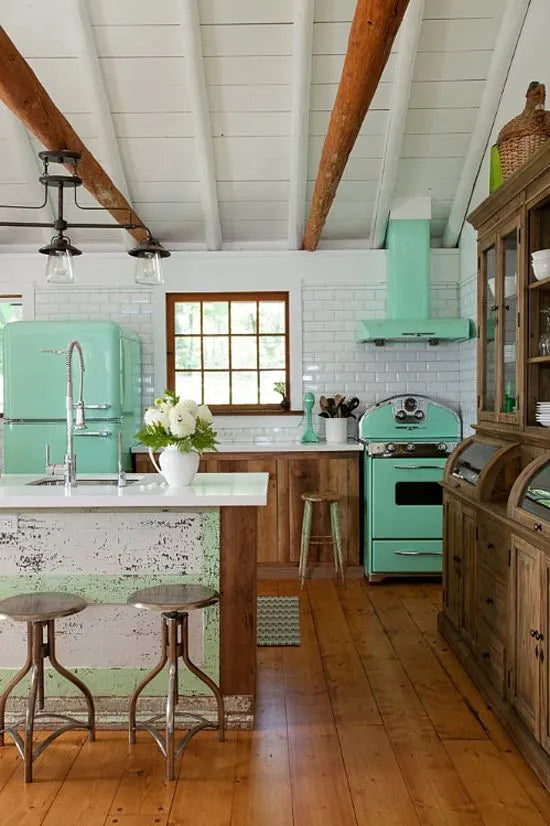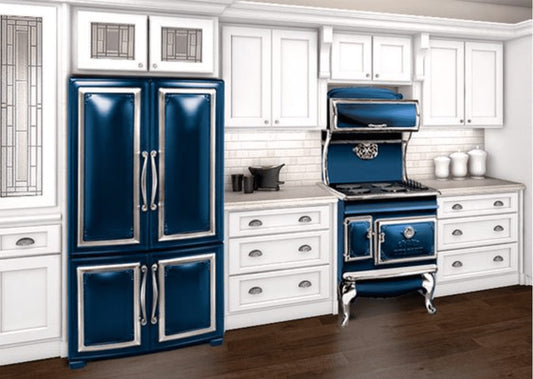Triangle Kitchen Design: Explained

When designing a kitchen, one of the most important principles to consider is the kitchen triangle. This concept has been a staple in kitchen design for decades, ensuring that your kitchen is both efficient and functional. But what exactly is the kitchen triangle, where did it come from, and how does it fit into today’s kitchen layouts? Let’s dive into the fascinating world of the kitchen triangle and explore its relevance in modern kitchen design, along with some new functional approaches that are gaining popularity.
What is the kitchen triangle?
The kitchen triangle, also known as the working triangle, is a design concept that helps create an efficient workflow in the kitchen. The idea is simple: draw an imaginary triangle that connects the three main work areas in the kitchen – the refrigerator, the stove (or cooktop), and the sink. These points represent the key areas where most kitchen activities take place: storing food, cooking, and cleaning up.
The goal of the kitchen triangle is to minimize the distance between these three points while ensuring that there are no major obstacles in the way. Ideally, each side of the triangle should be between 4 and 9 feet long.
The concept is that this design creates an easy flow of movement between the key areas of a kitchen. It makes it easy to cook, clean and should give the cook more time in their day with less time spent maneuvering around their workspace.

The history of the kitchen triangle
The concept of the kitchen triangle dates back to the 1940s. It was developed as part of a larger movement to improve the efficiency of household tasks and reduce the physical effort required by homemakers. This was a time when scientific management principles were being applied to domestic tasks, aiming to streamline workflows and improve productivity – a reflection of the industrial efficiency trends of the era.
Stationary sinks, the popularity of refrigerators, and improved design of stoves set in motion this idea of efficient cooking.
The kitchen triangle was popularized by researchers at the University of Illinois School of Architecture. They conducted studies on kitchen layouts and workflows. These studies narrowed down the “big three” of the kitchen. By organizing these elements in a triangular formation, they found that they could significantly reduce the time and effort needed to prepare meals and clean up.
This concept quickly gained traction and became a standard in kitchen design, influencing how kitchens were designed and built for decades to come. It provided a clear and practical guideline for architects and designers, making it easier to create functional and efficient kitchen spaces.
What it looks like in today’s kitchen
While the kitchen triangle remains a fundamental design principle, modern kitchens have evolved significantly since the 1940s. Today’s kitchens are often larger, more open, and more multifunctional than their predecessors, accommodating a variety of activities beyond just cooking and cleaning.

In contemporary kitchens, the triangle might not always be a perfect geometric shape due to the integration of islands, breakfast bars and other features. However, the core idea of having a streamlined workflow between the refrigerator, stove and sink still holds true.
In today’s open-plan designs, the kitchen often serves as a hub for socializing and entertaining. As a result, the traditional kitchen triangle has been adapted to accommodate multiple cooks and varied activities. Here are a few ways the kitchen triangle is applied in modern kitchens:
Island integration
Many modern kitchens feature islands that serve multiple purposes, from food preparation to casual dining. Islands can be integrated into the kitchen triangle by incorporating a sink or cooktop, effectively creating a multi-functional workspace that maintains the efficiency of the triangle.
Zoning
In larger kitchens, zones are created for different activities, such as prep, cooking, and cleaning. While these zones may expand beyond the traditional triangle, the principle of efficient movement between key work areas still applies. For example, a secondary triangle might be created within a specific zone to facilitate easy movement.
Multiple triangles
In kitchens designed for multiple cooks, more than one triangle can be incorporated to ensure that each person has their own efficient workspace. This approach helps to prevent congestion and allows for smoother collaboration in the kitchen.
New up-and-coming functional approaches to kitchen design
While the kitchen triangle remains a valuable guideline, new approaches have emerged to cater to modern lifestyles and evolving kitchen uses. Here are a few of the latest trends in kitchen design that complement or enhance the traditional triangle concept:
The work zone concept
This approach divides the kitchen into specific zones based on activities, such as food prep, cooking, baking, and cleaning. Each zone is equipped with the necessary tools and appliances, making it easier to stay organized and efficient. The work zone concept can work in tandem with the kitchen triangle by ensuring that each zone has easy access to the refrigerator, stove, and sink.
Ergonomic design
Modern kitchens prioritize ergonomics to reduce strain and increase comfort for the user. This includes considerations such as the height of countertops, the placement of frequently used items, and the ease of movement. Ergonomic design enhances the functionality of the kitchen triangle by making sure that all elements are within easy reach and at comfortable heights.
Smart kitchens
Smart technology has officially made its way into kitchens. Smart appliances like refrigerators that monitor food inventory, ovens that can be controlled remotely and faucets with touchless operation all contribute to a more streamlined and convenient cooking experience. These innovations can enhance the kitchen triangle by reducing the effort and time required for various tasks.
Open shelving and storage solutions
Efficient storage solutions, such as pull-out shelves, deep drawers, and open shelving, make it easier to access and organize kitchen items. These features can be strategically placed within the kitchen triangle to minimize movement and improve workflow.
Universal design
Universal design principles ensure that kitchens are accessible and functional for people of all ages and abilities. This includes features such as adjustable countertops, pull-out work surfaces, and easy-to-reach storage. Incorporating universal design into the kitchen triangle ensures that the space is usable and efficient for everyone.
The kitchen triangle: A great go-to for kitchen design
The kitchen triangle is a timeless design principle that has stood the test of time due to its practicality and efficiency. While kitchens have evolved over the decades, the core idea of creating a streamlined workflow between the refrigerator, stove, and sink remains relevant. By understanding the history and application of the kitchen triangle, you can create a functional and efficient kitchen that meets the needs of modern living.
Whether you’re designing a new kitchen or remodeling an existing one, consider how the kitchen triangle can enhance your space. Combine it with new functional approaches, such as work zones, ergonomic design and smart technology to create a kitchen that is not only efficient but also comfortable and enjoyable to use. With a thoughtful approach to design, you can create a kitchen that is truly the heart of your home.



